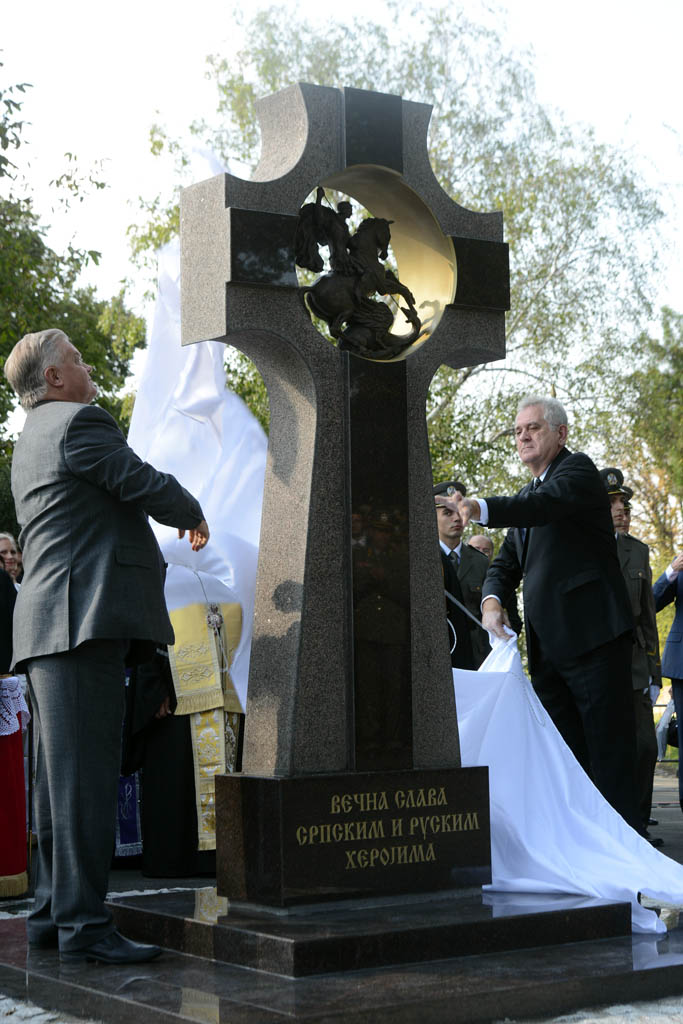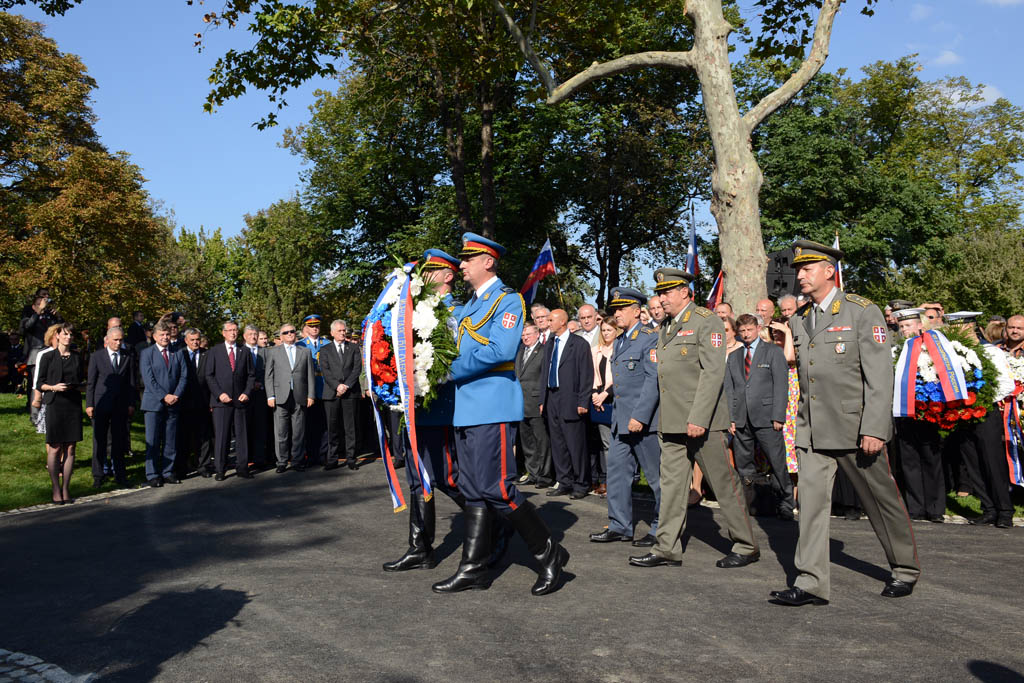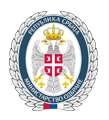- About MoD
Minister and Associates
- Minister
- State Secretary
- Assistant Ministers
- Secretary of the Ministry of Defence
Sectors
- Defence Policy Sector
- Human Resources Sector
- Material Resources Sector
- Budget and Finanance Sector
- Sector for Infrastructure and Hospitality Services
- SAF
- Documents
- Services
- Sport
- Archive
- Contacts
18.09.2014.
A monument to Russian and Serbian soldiers unveiled at Kalemegdan
In honour of the Russian and Serbian soldiers who died in defence of Belgrade during the First World War, a monument in the shape of a cross inscribed with the image of St. George the Victorious was officially unveiled at the Kalemegdan fortress. The ceremony of opening the memorial and wreath-laying ceremony were attended by Serbian President Tomislav Nikolic, Serbian Armed Forces Chief of General Staff General Ljubisa Dikovic, President of the Education Council of the International Social Fund "Centre of national glory," Vladimir Yakunin, Russian Ambassador to Belgrade Aleksandar Chepurin and Belgrade Mayor Sinisa Mali.
 Addressing the assembled guests and a large number of Belgrade citizens attending the unveiling of the monument, Serbian President Tomislav Nikolic said, among other things, that the monument erected to the Russian and Serbian defenders of Belgrade in the First World War is a boundary stone to show respect for the selfless sacrifice and gratitude for our lives in freedom.
Addressing the assembled guests and a large number of Belgrade citizens attending the unveiling of the monument, Serbian President Tomislav Nikolic said, among other things, that the monument erected to the Russian and Serbian defenders of Belgrade in the First World War is a boundary stone to show respect for the selfless sacrifice and gratitude for our lives in freedom. - When Austria-Hungary declared war on Serbia, while Belgrade was bombed on the other side of the Sava River, Russia, though unprepared for the warfare, mobilized its forces and entered the war sending to Serbia troops, finances, materiel, even that which it imported itself, or which it lacked itself. It was necessary assistance to defend the Serbian capital, especially in its rivers. Less than a month later, first mine torpedo detachment came to Serbia from Russia, followed by batteries of guns that have heroically fought from Sabac to Kladovo. Defending Belgrade also in 1915, Russian sailors, gunners and engineers heroically gave their lives. Today they rest in a common grave of Russian glory in Belgrade's New Cemetery. By the end of the Great War, Russia has formed a river fleet of the civilian and war ships whose task was to deliver military aid to Serbia. This Russian expedition, besides ships, included also coastal and anti-aircraft artillery, which ensured the flow of aid convoys and bringing up of supplies. In this mission more than 1,500 Russian soldiers gave their lives for the freedom of Serbia, Serbian President Tomislav Nikolic said among other things.
During the wreath-laying ceremony, on behalf of the Republic of Serbia, a wreath was laid by the President of the Republic Tomislav Nikolic, and on behalf of the Ministry of Defence and the Serbian Armed Forces a wreath was laid by Serbian Armed Forces Chief of General Staff General Ljubisa Dikovic. Wreaths were laid also by Vladimir Yakunin, Russian Ambassador to Belgrade Aleksandar Chepurin and Belgrade Mayor Sinisa Mali.
Memorial of the Russian and Serbian soldiers from the First World War who died at the Kalemegdan fortress, a granite cross with the image of St. George the Victorious, sculpted in bronze and a memorial plaque inscribed with "To the glory of the Russian and Serbian heroes" was sanctified by Serbian Patriarch Irinej with the concelebration of a representative of Patriarch of Moscow and all Russia Kiril, his Grace Bishop of Kronstadt Nazarije.
 Anyhow, the monument is the present of Russian social organizations "Centre of national fame" and Fund of Andrew the First-Called to the city of Belgrade, erected within the festive events dedicated to the centenary of the outbreak of the Great War. In the base of the cross there is the engraved text – tribute to Russian and Serbian heroes who died in defence of Belgrade on the walls of the Kalemegdan fortress, in the Russian and Serbian languages. The total height of the memorial is 2.7 meters. The shape of the monument derives from the shape of early Christian cross, widespread among Slavic peoples. The traditional Christian symbols of the cross and the image of St. George, the patron of the Russian and the Serbian armies, on horseback is reminiscent of the sacrifice of the soldiers of the Russian and Serbian peoples to freedom.
Anyhow, the monument is the present of Russian social organizations "Centre of national fame" and Fund of Andrew the First-Called to the city of Belgrade, erected within the festive events dedicated to the centenary of the outbreak of the Great War. In the base of the cross there is the engraved text – tribute to Russian and Serbian heroes who died in defence of Belgrade on the walls of the Kalemegdan fortress, in the Russian and Serbian languages. The total height of the memorial is 2.7 meters. The shape of the monument derives from the shape of early Christian cross, widespread among Slavic peoples. The traditional Christian symbols of the cross and the image of St. George, the patron of the Russian and the Serbian armies, on horseback is reminiscent of the sacrifice of the soldiers of the Russian and Serbian peoples to freedom.  PHOTOGALLERY
PHOTOGALLERY VIDEOGALLERY
VIDEOGALLERY- About MoD
- Jurisdiction
- Organisation scheme
- Description of duties
- Minister and Associates
- Minister
- State Secretary
- Assistant Ministers
- Secretary of the Ministry of Defence
- Sectors
- Defence Policy Sector
- Human Resources Sector
- Material Resources Sector
- Budget and Finanance Sector
- Sector for Infrastructure and Hospitality Services
- Special Internal Units
- Secretariat
- Office of the Minister of Defence
- Military Attorney's Office
- Administrative Bodies within MoD
- Defence Inspectorate
- Military Intelligence Agency
- Military Security Agency
- Autonomous Departments
- Public Relations Department
- Military Healthcare Department
- Higher Education Institution
- Defence University
- Specific internal units
- Inspector General of the Services
- Internal Audit Section
- SAF
- Documents
- Services
- Sport
- Archive
- Contacts

